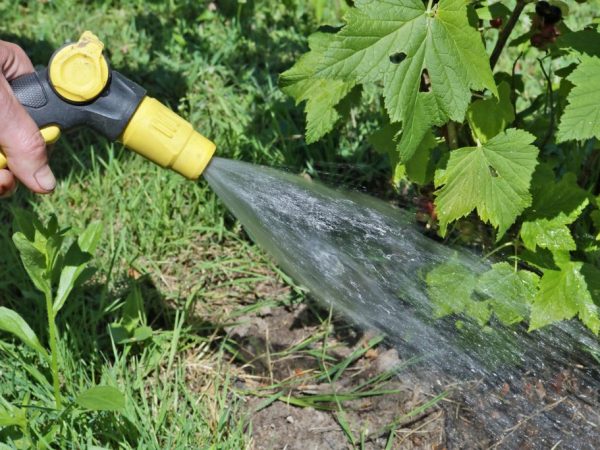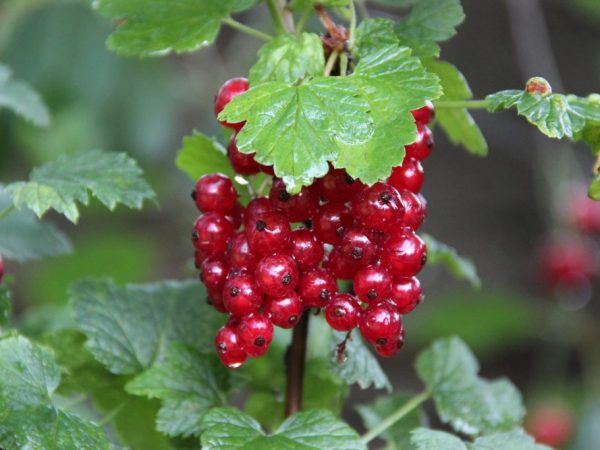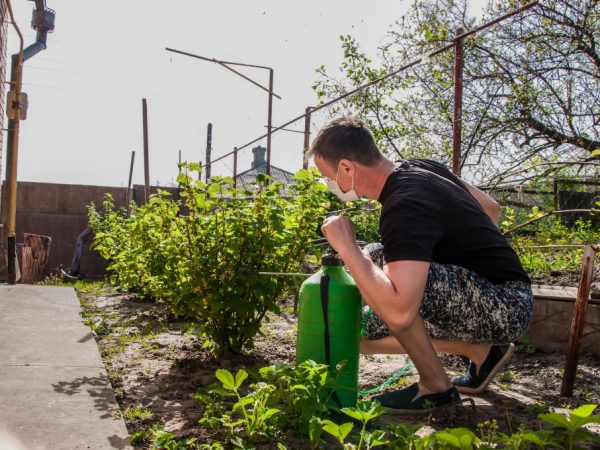Autumn processing of currants - how to organize work
Despite its high resistance and frost resistance, currants need preventive treatment and feeding after harvest. This helps to increase its productivity for the next year, as well as provide good protection against diseases and parasites. Let's consider how to carry out the autumn work.

Autumn processing of currants - how to organize work
Processing time
Gardeners advise three treatments of currants per season:
- before flowering, in early spring;
- in the phase of development of vegetative buds;
- in the fall, after harvest.
In addition to therapeutic measures, proper nutrition, pruning, watering and loosening the bushes before winter is required.
From pests
Harmful insects cause great harm to red, black and white currants.
Some suck the juice from the buds, shoots of foliage, others like to feast on leaves, gnawing holes in it, others eat juicy berries, which leads to their spoilage and unsuitableness for eating.
| Name | How to process | Rules of conduct |
| Moth butterfly | Iskra M, Fufanon, Actellik, Kinmiks, Karbofos and Rovikurt | Irrigate in the evening immediately after the appearance of parasites. The dosage is indicated on the package. |
| Aphid | Fufanon, Fitoverm, Iskra M, Intavir, Kinmiks, Kemifos, Karbofos | Spraying from aphids is carried out at the initial stage of the lesion twice with an interval of 7 days. |
| Kidney mite | Envidor, Contos, Movento, Oberon | It is necessary to spray the crown during infection two times at intervals of 12 days. |
| Shield | Inta-Vir, Aktara, Kinmiks, Kemifos, Fufanon | One-time irrigation of the bush and the soil under it. |
| Gallica | Bitobaxibacillin | They are processed in the spring, after flowering, and in the fall, after the foliage has fallen off. Dissolve 100 g in 10 l of water. |
| Whitefly | Aktellik, Inta-Vir, Fufanon, Kinmiks, Kemifos | Processing is carried out immediately upon detection of insects. The site is preliminarily cleared of weeds and plant debris. |
| Glass-maker | Spark, Movento, Contos, Oberon | First, diseased parts are cut out on the bushes, then carrion and fallen leaves are removed from the garden. The dosage is indicated on the package. |
| Sawfly | Lepidocide | Processed after flowering and harvesting berries - 100 g dissolve 50 g in a bucket of water. |
| Kidney moth | Spark | In early spring, it is necessary to remove all damaged and underdeveloped shoots, then treat with the drug (1 tablet per 10 liters of water). |
All procedures are carried out on a cloudy and dry day to avoid burning the leaves. After rains, re-spraying will be required, since the effect of the active substances is reduced.
The listed pesticides are suitable for the treatment of all types of this crop.
From disease

Plant health can be maintained
Currants are damaged by all sorts of sores, the causative agents of which are viruses, bacteria and fungi - if you spray them with appropriate drugs in time, the bushes can be saved.
| Name | How to process | Rules of conduct |
| Powdery mildew | Topaz, Fundazol, Ampelomycin | For the first two drugs, the scheme and the amount according to the instructions, in the latter case, a suspension of 0.5% concentration is used. Frequency of irrigation of bushes 3 times per season with an interval of 10 days. |
| Septoria (white spot) | Alirin-B solution | Dissolve 2 tablets in 1 liter of water, add liquid soap (1 ml). Processed up to 5 times with a frequency of 7 days. |
| Anthracnose | Bordeaux liquid, Alirin-B | Processing is needed after harvest. The dosage and regimen of Alirin-B use is the same as in the treatment of septoria. |
| Rust | Bordeaux liquid solution (1%), Alirin-B | Dissolve 2 tablets of Ailirin-B in 1 liter of water, add 1 ml of liquid soap. Irrigate twice with an interval of 10 days. |
| Reverse (terry) | Pentaphage | In order to avoid infection with this disease, you should choose healthy seedlings for planting, and also inspect them in time for damage. processing is carried out three times per season. Dilute 200 ml of the substance in 10 liters of water. |
| Striped mosaic | Not subject to treatment | Sick bushes are dug up and burned. The soil where they grew must be treated with copper sulfate, Bordeaux liquid or a strong solution of potassium permanganate |
| Gray rot | Trichodermin | Requires five times spraying of bushes and land. The interval is 7 days. The dosage is 10 g per 5 liters of water. |
In order for treatment for diseases to bring the desired result, it is performed in dry, cloudy weather. After the rains, it is carried out again, since the water washes away the active components.
Top dressing and tillage
Chemicals help to cope with various infections and pests of the culture, but in addition, to increase immunity, the bushes must be properly prepared for winter.
Pruning

Bushes must be treated from pests
Autumn pruning of black, red or white currants before winter has a beneficial effect on development in spring.
It also helps protect it from the appearance of infections and parasites during the cold season:
- In the process of sanitary cutting, all branches are removed that are injured, diseased or dry out. Additionally, the areas damaged by the glass are cut out. They are usually lethargic, dry and with a black core. The procedure is carried out with a sharp and sterile object. The diseased parts are cut off to healthy tissue, the heavily infected are mercilessly cut into a ring.
- Old black and red currants need to be rejuvenated before winter. This is done gradually - over the course of three years, a third of the shoots are removed. All trimmings are burned, since they are the source of the development of infections. The thickest branches must be treated with iron, copper sulfate or Bordeaux liquid.
- The final process of the autumn pruning preparation will be the irrigation of the bushes with Karbofos or a solution of colloidal sulfur. Additionally, the soil under them is sprayed, where pathogens and pest larvae usually live.
Watering
After fruiting, currants need abundant water-charging irrigation, which will ensure successful budding for the next year and good frost resistance.
Immediately after pruning, watered with warm, settled water. The consumption for red bushes is 2, for black - 4 buckets.
The increased need for moisture in plants with black berries is due to the peculiarity of the root system - it is located close to the soil surface.
Loosening and mulching
The loosening procedure after watering increases the moisture and air permeability of the soil. This improves the access of water and nutrients to the roots. Loosening is not too deep (5-6 cm) to prevent injury to the root system.
Additionally, weed shoots are removed and the soil is weeded between the rows. At the end, mulch with peat or last year's manure to avoid moisture evaporation.
Processing recommendations
The introduction of useful components into the soil will provide plants with a good wintering and protection from diseases and pests.
Mineral compositions
If, when planting in the pits, mineral components were laid, then the first feeding begins only in the third year.
In the fall, a month before the onset of cold weather, a mixture of chlorine-free potassium and double superphosphate, 10 g in granular form, is introduced. After that, abundant watering is carried out so that the root system can absorb all the nutrients.
Organic fertilizers
Organic matter is brought in in November - by the spring it will have time to decompose completely and will have a positive effect on the further growth, flowering and fruiting of the bushes.
Manure is used in liquid form: 1 kg is dissolved in 5 liters of water, then infused for five days, brought to a volume of 10 liters with water. Poured at the root. Consumption per plant - a bucket.
To increase the yield in spring and before winter, an infusion based on chicken manure is introduced. The optimal proportion is 1:12. 10 liters of working fluid are poured under one bush.
Severely depleted plants after abundant fruiting need autumn feeding with nitrophos according to the instructions. Additionally, the leaves are sprayed with Zircon, which helps to survive the winter safely.
In order to avoid the development of chlorosis, which is typical for all types of currants, they are fed with urea - 1 tbsp. l. the substances are dissolved in 10 l of water.
Summing up
Throughout the growing season, currants need timely and correct treatment from various pests and diseases.
Observing the above technology, you can grow healthy, strong and abundantly fruiting bushes.

